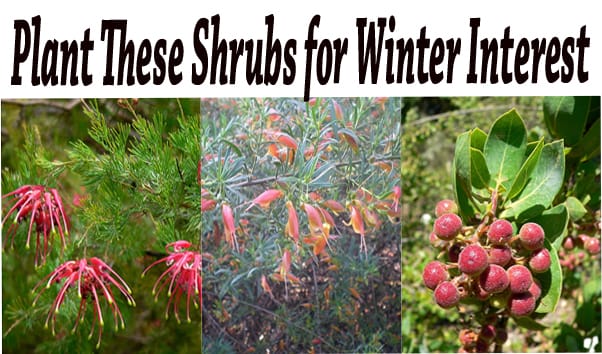Newsletter Articles
Plant These Shrubs for Winter Interest
Written by Susan B.
Our magnificent and mild Southern California climate blurs the lines between seasons. Naturally, it may not occur to us to think about plants that bring our front or backyards to life throughout each season. We believe that a well-balanced landscape design incorporates green and flowering plants, shrubs, and trees that offer interest at different times during the year. During the winter, many plants go dormant. They go into hibernation. It is a period during which plants that provide interest at other times of the year rest, storing up energy they’ll need when new growth emerges in the spring. Plants and shrubs offer winter interest with berries that feed wildlife, or the colors and textures of tree and shrub trunks, their branches, or small twigs. Let’s look at some of our top shrub choices for winter garden interest.
Grevillea Ianigera ‘Coastal Gem’
Grevillea Ianigera belongs to the genus Grevillea. It is considered a broadleaf evergreen shrub, and it is native to Australia. The genus name is a tribute to Charles Francis Greville, one of the founders of the UK’s prestigious Royal Horticultural Society, which was founded in 1804. Since its native habitat is in the Southern Hemisphere, it makes sense that it would be at its best during Southern California’s mild winters. It is a low growing shrub — with a maximum height of 12-inches. It makes up for what it lacks in height with its sprawling growth habit, spreading to a width of about 4 ½ feet.
Grevillea Ianigera ‘Coastal Gem’ produces narrow grayish-green leaves that form clusters on the shrub’s branches. Tight clusters of cream and reddish-pink colored flowers grow off the branch tips. This Grevillea cultivar is hardy between zones 8 and 11. It is tough enough to withstand rugged conditions, including salt spray from coastal areas, and drought. It will grow in either sun or partial shade, and it does best in neutral to slightly acidic soil. The flowers attract hummingbirds, so Grevillea is a useful winter pollinator plant.
Eremophila maculata ‘Valentine’ (Valentine Emu Bush)
Valentine Emu Bush, also known as Red Emu, and Spotted Emu Bush, is a native of inland Australia. It is a low-growing evergreen shrub that belongs to the Myoporaceae family. This particular Eremophilia cultivar is compact and has a growth habit that results in a rounded shape. Once established in the landscape, it grows slowly, ultimately reaching a maximum height of between 3-and-5 feet, and spreading to a width of between 4-and-6 feet.
Valentine Emu Bush can adapt to any soil pH, but it needs well-drained soil. Because of its adaptability, it’s well-suited to coastal areas where many shrubs can’t tolerate the salt spray. Throughout the summer months, foliage on Red Emu is a dull grayish-green color. Fall foliage goes from grayish-green to green and red. During the winter months, the leaves turn to a purplish-grayish-green color. As its name suggests, Valentine Emu Bush is showiest during winter and spring when it produces a profusion of 1-inch long tubular red flowers that appeal to butterflies and hummingbirds. After flowering, the shrub is covered with small, barely perceptible round berries.
Eremophila maculata is hardiest in USDA growing zones 9 -10. Because of its drought tolerance and minimal maintenance needs, it is an excellent addition to a Xeriscape landscape design.
Arctostaphylos glauca (Big Berry Manzanita)
Big Berry Manzanita is native to California and Baja California, Mexico. Depending on where it grows, it can be considered a large shrub or a small tree. Plants that grow inland are smaller. Big Berry Manzanita has leaves that are 5 centimeters long (1 31/32 inches), and 4 centimeters wide (1 37/64-inches), The leaves have a waxy feel and are a light grayish-green color. Their shape lies between oval and nearly round, and they can be entirely smooth or have jagged-tooth edges. Leaves grow on petioles that measure roughly 1 centimeter (25/64 inches). Big Berry Manzanita produces hanging clusters of pink or white flowers, which are narrow and urn-shaped. It blooms in winter and in spring.
After flowering, Big Berry Manzanita shrubs produce large edible fruits that are larger than the fruits of any of the Manzanita cultivar. The drupe (stone) fruits are typically round or egg-shaped and measure between 12 (15/32 inches) and 15 (19/32 inches) millimeters wide. The plant’s fruits have a light-red thick pulp, but the outer skin (or coat) is tough and sticky. Under the fruit pulp, there is a fused mass that contains 3 to 6 nutlets.
The plant reproduces via seeds that fall on the ground and are then exposed to fire (from wildfires.) Big Berry Manzanita has a long lifespan – living for 100 years or more. The best site to plant Big Berry Manzanita is near large rocks. If that isn’t possible, you can surround the shrub’s roots with large stones. In dry areas of its native range, it performs best on north-facing slopes or near creeks where there is partial shade. After the first year of growth, the shrub won’t tolerate direct water during the summer months.
Big Berry Manzanita grows to a height of between 3.3 feet and 20 feet, and a width of between 6 feet and 20 feet. Its growth habit is upright or in a vertical column. Its growth rate is slow to moderate. Flowers attract bees, butterflies, and hummingbirds, and fruits attract other birds.
Our inventory is always changing, but you can count on us to carry seasonal plants, shrubs, and trees that are suited to our growing areas. Call us or come in to talk one of our garden experts about finding shrubs that will bring winter interest to your property.
Do you like what you see? Sign up for our weekly newsletter to get content like this every week!
CLICK HERE TO SIGN UP!

